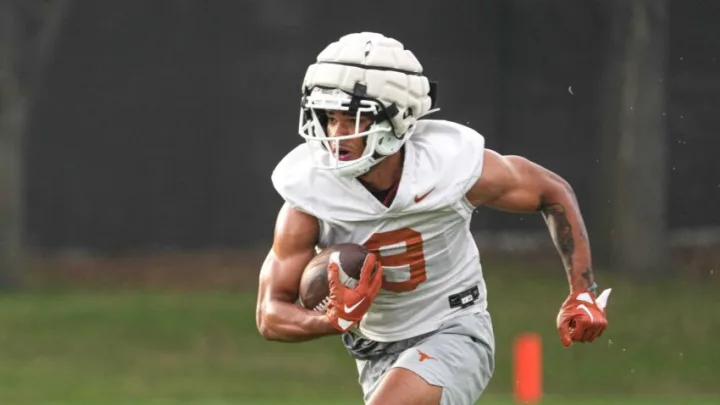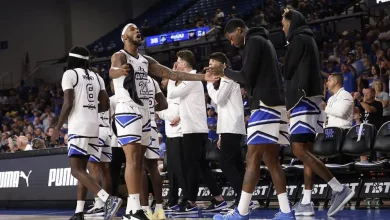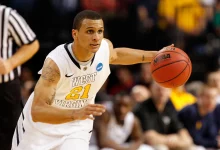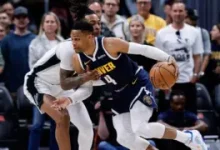Due to an injury, Longhorns wide receiver DeAndre Moore Jr. misses spring exercises.

DeAndre Moore Jr.’s Injury and Its Impact on the Longhorns’ 2025 Spring Exercises
The University of Texas Longhorns’ football program has seen a wave of success in recent years, with several top-tier recruits and emerging stars contributing to their rise in national prominence. Among these rising stars is wide receiver DeAndre Moore Jr., a player who has been making waves in the football world since his high school days and was expected to be one of the focal points of Texas’ offense in the upcoming 2025 season. However, Moore Jr. recently suffered an injury that will keep him out of the team’s spring exercises, creating uncertainty for both him and the Longhorns’ offensive strategy moving forward.
DeAndre Moore Jr.’s absence during spring practices represents a significant blow to both the player’s development and the team’s offensive plans for the 2025 season. As Texas aims to build on its recent success and make a deeper run in the College Football Playoff picture, Moore’s injury presents challenges for both the coaching staff and the player himself. This article will explore the details surrounding Moore Jr.’s injury, its potential effects on the Longhorns’ spring practices and the upcoming season, and how the team plans to move forward in his absence.
DeAndre Moore Jr.’s Rise to Prominence
Before diving into the specifics of Moore’s injury and its implications, it’s essential to take a step back and understand the talent and potential that Moore Jr. brings to the Longhorns. A 5-star recruit from Los Alamitos High School in California, Moore’s path to Texas has been anything but ordinary. Rated as one of the top wide receiver prospects in the 2024 recruiting class, Moore had an illustrious high school career that featured eye-popping statistics, including over 1,200 yards and 15 touchdowns in his senior season.
What made Moore even more appealing to college programs was his versatility. Standing at 6’0” and weighing 190 pounds, Moore possesses a blend of size, speed, and agility that allows him to excel both as a deep threat and in short-yardage situations. Whether running crisp routes, making defenders miss in the open field, or stretching the field with explosive deep balls, Moore’s game seemed tailor-made for a big-time program like Texas.
Moore’s commitment to Texas was a major win for head coach Steve Sarkisian and his staff. With the Longhorns looking to solidify their offense and develop a more potent passing attack, Moore was expected to become an immediate contributor to a receiving corps that already boasted a few talented veterans. His potential to be a game-changer on the field was clear, and many viewed him as a key piece in Texas’ long-term plans to compete for a national championship.
The Injury: What We Know So Far
As with any major collegiate football program, spring practices represent a critical period for players to refine their skills, build team chemistry, and establish themselves in the depth chart. For someone like DeAndre Moore Jr., who was expected to be a key weapon in Texas’ offense, the spring period was particularly important. Unfortunately, Moore Jr. suffered an injury during offseason training, an issue that will prevent him from participating in the spring exercises. While the details of the injury have been somewhat guarded, reports suggest that it is a lower-body injury, though the specific nature of the injury (whether it’s a sprained ankle, hamstring issue, or something more serious) has not been publicly confirmed.
The timing of Moore’s injury is particularly unfortunate, as spring practices provide an important opportunity for players to build a rapport with their quarterbacks and get acclimated to the team’s offensive system. For Moore, who was expected to play a central role in the offense, missing spring workouts means that he will be behind in terms of on-field development and continuity with his teammates. This could be especially problematic in a high-tempo offense like that of Sarkisian, where timing, routes, and chemistry with the quarterback are critical to success.
The Impact on the Longhorns’ Offense
Moore’s absence during spring exercises is likely to have several implications for the Longhorns’ offensive plans in 2025. The coaching staff had big expectations for Moore to come in and contribute immediately, and losing that opportunity for spring development could set the team back in some respects.
1. Limited Chemistry with Quarterbacks
In any passing offense, the connection between the quarterback and wide receiver is paramount. DeAndre Moore Jr. was expected to develop chemistry with starting quarterback Quinn Ewers during the spring, giving both players a chance to build trust and familiarity with each other’s timing, tendencies, and style of play. The spring exercises would have allowed Moore to get in sync with Ewers, who will be entering his second full season as Texas’ starting quarterback in 2025.
Without Moore participating in spring drills, it will be harder for Ewers to build that rapport with him. While the two will still have opportunities to work together in the summer and fall camp, missing out on spring practices could make their early-season connection a little less polished. For a team that aspires to compete for championships, even small disruptions like this can have significant ripple effects.
2. More Opportunities for Other Receivers
While Moore’s injury is unfortunate, it does present an opportunity for other wide receivers on the Texas roster to step up in his absence. Players like Xavier Worthy, Jordan Whittington, and Ja’Quinden Jackson are expected to be heavily involved in the offense this year, and their chances to secure higher roles in the passing game are enhanced by Moore’s absence.
Worthy, in particular, has been a standout performer for the Longhorns over the past two seasons, and the spotlight may now shine even brighter on him. With Moore sidelined, Worthy could take on an even larger share of the receiving load, and Texas’ coaching staff will likely lean on him more as a deep threat and reliable target. Additionally, Whittington, who has shown flashes of brilliance during his time at Texas, may be in line for a more prominent role in the passing game.
Freshman wide receivers and other young talents may also seize the opportunity to prove themselves during spring practices. These players will be looking to develop more rapport with the quarterbacks and earn a spot on the depth chart, whether as a backup or a starter. For the Longhorns, this increased competition among receivers will help strengthen the depth of the wide receiver room, which is essential for any successful team.
3. Adjustments to Offensive Schemes
Offensive coordinator Sarkisian is known for his innovative and diverse offensive schemes. His offense relies on spreading the ball around to multiple receivers, utilizing both big-play targets and smaller, more versatile players to create mismatches across the field. DeAndre Moore Jr. was expected to be a key piece in this system, given his ability to run a wide range of routes, his versatility, and his ability to make plays in multiple ways.
Without Moore, Sarkisian will need to adjust his plans for the spring. While Texas has other talented receivers, Moore’s skill set is unique, and losing him means the coaching staff must adapt the offense to better fit the available personnel. The Longhorns might lean more heavily on their veteran receivers like Worthy and Whittington to make up for the absence of a player with Moore’s potential.
Moreover, the Longhorns may focus on a more run-heavy approach in the spring if the passing game lacks a key playmaker like Moore. The development of the running game, particularly with running backs like Bijan Robinson and Roschon Johnson leading the charge, could become even more important as the offense adapts to Moore’s absence.
4. Development of the Young Quarterbacks
While Quinn Ewers is the expected starter for the 2025 season, Texas has some talented young quarterbacks who are vying for their place in the depth chart. Malik Murphy and Arch Manning, the highly touted freshman, both provide intriguing potential as future leaders of the offense. These quarterbacks will benefit from spring practices to improve their timing and get real-game experience with their receiving corps.
However, without Moore in the mix, the quarterbacks may not get to showcase their full potential or develop a strong connection with a key piece of the offense. Although other receivers will step up in Moore’s absence, the lack of one of the primary playmakers could lead to some inconsistencies as these young quarterbacks continue to hone their skills.
The Path Forward: Moore’s Recovery and the Longhorns’ Outlook
The most important factor moving forward will be DeAndre Moore Jr.’s recovery. While missing spring practices is certainly a setback, it’s important to note that Moore is a talented player with the potential to make a major impact when he returns to full health. If he can recover in time for the summer workouts and fall camp, he still has an opportunity to be a key player in the Longhorns’ offense in 2025.
For now, Texas will continue to lean on its depth of talent at the wide receiver position and adjust its offensive strategy to account for Moore’s absence. Head coach Steve Sarkisian and the coaching staff will make the necessary adjustments to ensure that the offense remains dynamic, even without Moore in the mix for spring practices.









